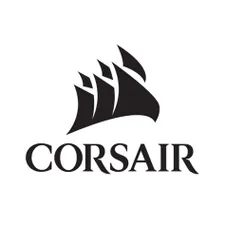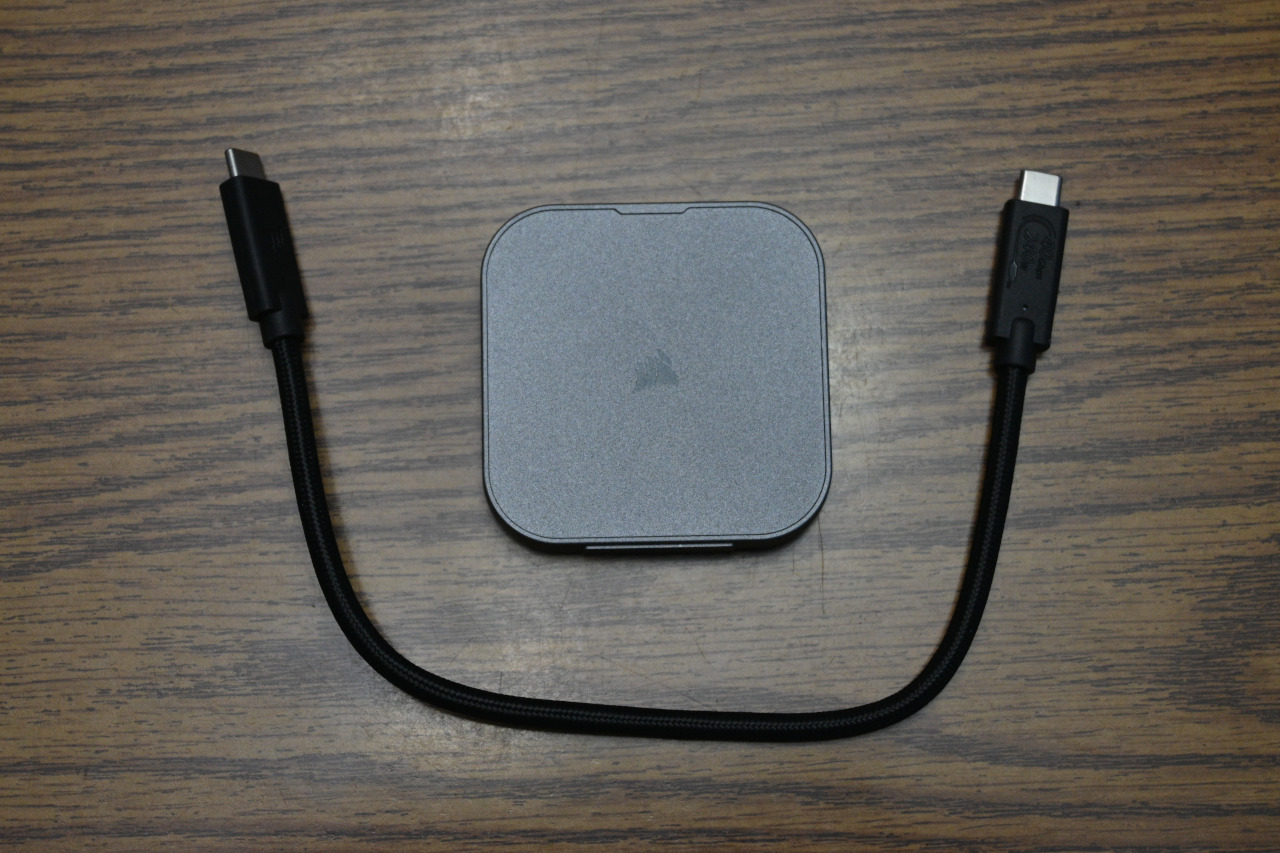Search
[{{{type}}}] {{{reason}}}
{{/data.error.root_cause}}{{{_source.title}}} {{#_source.showPrice}} {{{_source.displayPrice}}} {{/_source.showPrice}}
{{#_source.showLink}} {{/_source.showLink}} {{#_source.showDate}}{{{_source.displayDate}}}
{{/_source.showDate}}{{{_source.description}}}
{{#_source.additionalInfo}}{{#_source.additionalFields}} {{#title}} {{{label}}}: {{{title}}} {{/title}} {{/_source.additionalFields}}
{{/_source.additionalInfo}}- Details
- Category: Hardware
- By Jason Gress
- Hits: 1421
Corsair EX400U 2TB USB4 External SSD

Corsair EX400U 2TB USB4 External SSD
USB4 External SSD with USB-C connection interface
USB4 40Gb, Thunderbolt 4, and USB-C supported
Available in 1TB, 2TB, 4TB sizes (2TB reviewed)
Read Speed: Up to 4,000MB/s
Write Speed: Up to 3,600MB/s
Dimensions: 2.5" x 2.5" x 0.5"
Weight: 49g for drive, 16g cable
12" 40Gb 240W USB-C to USB-C cable
Gunmetal finish
3 year warranty
MSRP: $199.99
(Amazon Affiliate Link)
Thank you Corsair for sending us the 2TB version of this drive to review!
The last time we reviewed a USB drive was quite a few years ago, when SATA SSDs were state of the art. Things have changed quite a bit since then, and the gap between internal and external interfaces has shrunk quite dramatically. While USB 3.0 seemed fast at 5Gb/s and USB 3.1 is pretty fast at 10Gb/s, NVMe has taken over the world when it comes to solid state drives. USB 3 is fine for SATA SSDs, since the SATA interface maxes out at 6Gb/s, but NVMe drives are limited by their PCI Express (PCIe) lanes (2x of 4x, depending on the drive). Thankfully, when USB4 was released, they decided to make it largely compatible with Intel's Thunderbolt 3/4 standard, which is a newer technology that allows up to 4x PCIe lanes to be embedded in the USB protocol. So while there is some protocol overhead, it's much less than a normal USB device, and it's wicked fast.
As a result of Corsair using this new USB4 protocol on this 2TB drive, we get to enjoy near-native NVMe speeds without having to open our computer. It turns out that the latest AMD platforms support USB4, while the latest Intel platforms support Thunderbolt 4; they are largely cross compatible, but there are slight differences. It turns out that while I have several Thunderbolt computers, and tested this drive on them, the one USB4 machine I have is AMD's earliest USB4 platform, and it has some bugs. My GPD Win Max 2 that I featured in our unboxing video is a very early USB4 platform, using the AMD Ryzen 6800U. That USB4 port is confirmed to work with eGPUs that encapsulate graphics cards over PCIe, but another user there with a Thunderbolt drive was able to confirm that he also could not get it to work in that singular USB4 port, just as I was unable to get it to work. So unfortunately, I can only test this EX400U with a Thunderbolt 4 port, for now.
I tested this drive on several Intel Thunderbolt machines; the main system I did my testing on is an Acer Predator Helios 18 (2024) gaming laptop with two Thunderbolt 4 ports in the rear. It has an Intel 14900HX CPU, which was the latest Intel platform as of about a year ago. I also tested the drive on an older Intel i5-1135G7, which features two older Thunderbolt 3 ports. (Thunderbolt 3 and 4 have the same maximum bandwidth and PCIe lanes; TB4 just standardizes some optional features from TB3.) I can confirm that both systems detected the drive perfectly, and connected over Thunderbolt. When connected over Thunderbolt, the performance is dramatically better, but other than pure transfer rate, the PCIe interface is connected to the CPU (or chipset, depending on the design), and requires much less CPU time for the operating system to manage the USB interfaces. While USB is great, it is largely CPU-driven, so heavy I/O can slow down system responsiveness. Connecting over Thunderbolt or USB4 largely removes that additional system load, so if you can, I recommend using this drive that way.
When I unboxed and saw the drive for the first time, the thing that struck me was how small and premium the Corsair EX400U drive itself felt. First, it's absolutely tiny, at a 2.5" x 2.5" x 0.5" size. It's also fairly light at 49 grams for the drive and 16 grams for the cable. You could easily toss it in a bag and not notice. The other thing I noticed is it has a similar gunmetal finish to the Corsair Virtuoso Max gaming headset I recently reviewed; I praised that headset for the premium look and feel, and that carries over here. It looks and feels quality when in use.
Strong Points: Fantastic and consistent performance even when full; very high performance when connected to a USB4 or Thunderbolt connection; still very fast when connected via USB; looks and feels very high quality, both the enclosure and cable
Weak Points: I only measured 3,200MB/s when connected via Thunderbolt 4; I wish it included a pouch to keep the cable safer from being lost
When it comes to using the drive, there really isn't much to it. It has a single USB-C port, and includes a very high-quality 12" cable in the box. Corsair's site says it includes a 40Gb/s 60W cable, but mine included a nicer 40Gb/s 240W cable. While I don't think it matters much, they didn't skimp out on the cable, and that's great. While testing, I connected it to several machines, some with Thunderbolt ports and some with USB3 ports. My desktop only has USB 3.2 ports; I have one on the case in front and one in the rear. Both worked, but the rear port had slightly better benchmark results. Windows did complain that the device supports USB4, but the port did not.
Since I wanted to give this drive the best environment I could, I did the majority of testing with that Helios, and I am extremely impressed. While I was not able to hit 4,000MB/s, possibly because of the difference between USB4 and Thunderbolt 4, I was able to see CrystalDiskMark scores of just a bit under 3,200MB/s for sequential reads, and sequential writes just below that. These are very impressive numbers. From what I can tell it's very close to the maximum possible for a Thunderbolt 4 port, and right below what a PCIe Gen 3 NVMe drive can achieve inside of a computer. For an external drive, not only are these excellent results, but close enough to internal that most users might not be able to tell the difference.
As good as maximum performance is and can be, in reality, many SSDs tend to have great boost performance for quick tasks, but often sustained performance can really tank. This is especially true on drives with QLC NAND flash, or not enough cache. I don't know what kind of NAND flash that this drive has, but I performed several tests with this drive, and I was shocked at how reliable its performance is. Often with SSDs, when you try to fill them up they slow down dramatically either as caches fill up, or when the drive itself does. And while it certainly performed the best when near empty, the performance was shockingly consistent, even when copying hundreds of gigabytes at a time.
I filled up the drive to nearly 100% full, with just a few GB free. I have a large storage array on my network, and I have a bunch of (owned) movies stored there. I took a bunch of 4K videos that are around 50GB each and copied them to my local NVMe drive, then copied them to the Corsair EX400U afterwards. Since I don't have 2TB free on my local drive, I copied just under 700GB at a time to the Corsair. Each time, the copy was insanely fast. It started at around 1.22GB/s, and what's crazy is that it went at that speed the whole time. I expected it to slow down at some point, since even my 2TB Intel NVMe did that. But this drive just never did.
While CrystalDiskMark isn't a perfect test, it is useful as a snapshot of drive performance in the state that it's in. I took a snapshot at 0% full, another at 65% full (after two movie copies), and a final one at 100% - 1854 of 1863GiB. (CrystalDiskMark needs 5GB free to operate.) The read performance was basically indistinguishable between 0% and 65%, it only went down a few percent even at 100%. Write performance is impacted a lot more, but not enough to slow down the file copies all that much. The final 700GB did slow down for moments here and there, but went back up to 1.2GB/s again. The CrystalDiskMark results at 100% full for writes have the performance drop by about 50%, but it's still a bit over 1,600MB/s.

When I tested this drive on my desktop, of course performance was a lot lower. Since that machine doesn't have USB4 or Thunderbolt, I was limited to USB 3.2. I saw CrystalDiskMark scores of right around 1,000MB/s reads and 850MB/s writes. These speeds are certainly a lot slower than what Thunderbolt offers, but still quite fast.
I also tested this drive as well as a few others with 3DMark's storage benchmark. It's a bit of a strange benchmark, and its results suggested that something might be funky with one of my other drives. The good news is that this Corsair drive performed reasonably well and would be an excellent drive for playing stored games.
This drive continues to surprise me. It's small, really portable, and the performance is excellent. When I first saw it, I really thought about if it was worth the price or not, because it's a lot more expensive than just buying an internal NVMe drive. But what surprised me is how expensive external cages are for Thunderbolt/USB4 NVMe drive adapters. If you are willing to settle for a no-name brand, these converters start at around $70. And then of course you need to buy a high-quality drive to put inside that converter. On top of that, most of these adapters are larger than this Corsair drive, also.
All of this to say, even for the technically inclined, this drive offers a compelling product and even a pretty good value. Would you spend an extra $20 to get a drive from a reputable manufacturer and is less than half of the size? The bottom of the drive even has a magnet so you can easily attach it to a mobile device!
I am extremely impressed with this Corsair EX400U 2TB USB4 External SSD. It's really small and light, and feels premium to the touch. It has small touches like that crazy magnet for mobile use, and the performance is excellent. There are also 1TB and 4TB models available if those sizes are more appropriate for you. If you are in the market for an external SSD like this and have USB4 or Thunderbolt ports on your machine, then I definitely recommend this drive. If you're stuck with USB 3.x, I would still recommend this drive, but cheaper options are available. If you need an external SSD, I highly recommended checking out the Corsair EX400U!








